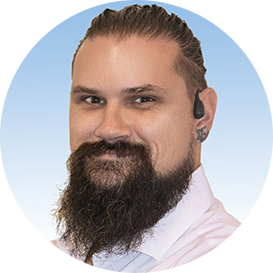For many people diagnosed with major depressive disorder or bipolar depression, traditional therapeutic approaches such as psychotherapy and antidepressant medication work well and offer significant relief. However, for around one third of people diagnosed with a depressive disorder, evidence shows these standard treatments are not effective.
Innovative Approaches to Treatment-Resistant Depression
When an individual with a depressive disorder tries traditional treatments but does not experience relief from their symptoms, meet their treatment goals, or show signs of improvement, clinicians describe their condition as treatment-resistant depression, or TRD.
However, there are several new, leading-edge therapies for treatment-resistant depression that can help when traditional therapies do not. Evidence shows that one of these inventive new approaches – which leverages advances in the field of electromagnetic induction and magnetic resonance imaging – can help patients with TRD experience the relief that may have eluded them for years.
This new approach is called transcranial magnetic stimulation, or TMS. Research shows that for people with TRD, this contemporary, 21st century therapy can:
- Lead to remission in 30-40% of cases of TRD, according to studies here and here
- Lead to positive symptom reduction short of full remission in 50-60% of cases of TRD, according to research published here
- Reduce depressive symptoms for at least three months, according to data published here
In addition, evidence shows that TMS can reduce depressive symptoms in patients with an average of 3-4 unsuccessful treatment attempts with traditional psychotherapeutic and/or antidepressant medication. In a group of 100 patients with multiple unsuccessful previous treatment attempts:
- 51% of patients reported reduction of depressive symptoms at six weeks post-treatment
- 62% of these patients reported continued symptom reduction at three months post-treatment
- 25% of patients reported full remission at six weeks post-treatment
- 58% of these patients reported continued remission at three months post-treatment
To explore this data in detail, please click the links in the bullet points. For an in-depth overview of the clinical efficacy of TMS for TRD, please navigate to the journal article in the link preceding the bullet points called “The Expanding Evidence Base for rTMS Treatment of Depression.”
How TMS Works: Mechanism and Administration
Mechanism of Action
Most people are familiar with the broad strokes of how this type of technology works. In magnetic resonance imaging (MRI), for instance, clinicians apply a combination of magnetic and electrical energy from an external source to internal structures in the human body. The way the atoms in those structures respond to those externally generated electromagnetic fields allow clinicians – supported by advance computer software – to create an accurate picture of those structures.
TMS for TRD uses the same concepts, but in a completely different way.
Experts on the neurobiology of depression indicate that one primary component of the disorder is decreased activity – or a total lack of activity – in brain cells in specific brain areas related to mood and emotion. Transcranial magnetic stimulation targets those areas of the brain with magnetic pulses that create small electrical currents that change neuronal firing patterns in ways that benefit people with treatment resistant depression.
In other words, TMS can stimulate – or restart, reset, and re-energize – those brain cells. This stimulation can lead to symptom relief, and in some cases, as indicated above, can lead to full remission of depression in some people with TRD.
Administration
Although the technologies are similar, treatment with TMS is much different than receiving an MRI scan.
Here’s how it works:
- In an office setting, under the supervision of licensed and qualified clinicians, patients recline comfortably in a medical chair – like a dentist’s office – or a typical medical exam bed, like those most of us know from hospitals, emergency rooms, or urgent care exam rooms.
- Administration does not require anesthesia or sedation
- Clinicians place a small electromagnetic coil on the scalp, which is attached to a unit that generates the electromagnetic field, and a monitor that allows clinicians to monitor the procedure
- Clinicians activate the unit, which generates small, repetitive electromagnetic pulses that pass harmlessly through the skin of the scalp, the skull, and stimulate the target structures within the brain
- Depending on the protocol determined in advance through collaboration between physician and patient, the procedure can last between five minutes and one hour
- Patients typically receive one session per day, five days a week, over a period of four to six weeks, with most patients receiving a total of 20-30 sessions per course of treatment
The subjective experience:
- For most patients, the procedure is completely painless and has no side effects at all.
- In some cases, patients report involuntary eye twitching or the involuntary contraction of facial muscles during the procedure
- In rare cases, patients report mild headache, or mild pain at the stimulation site.
- Headache and stimulation site discomfort typically receded within 24 hours of treatment
According to information published by the Harvard Medical School, about 50-60 percent of people who receive TMS therapy experience meaningful symptom relief. Around one third experience complete remission, meaning total absence of symptoms. Most patients report symptom relief for several months, with the average duration of benefits lasting a year or more.
Consequences of Treatment Resistant Depression
Many patients with TRD become discouraged or give up hope. The lose faith that any treatment – new, old, or experimental – will give them any relief at all. This can be very discouraging. Losing hope can compound and exacerbate symptoms of depression that are already disruptive. People with TRD know their symptoms can have a negative impact on their relationships, their work performance, their academic achievement, and their motivation to participate in favorite hobbies or activities.
That’s why we offer innovative therapies like TMS: they can work and offer real, significant relief for patients who come to use and say things like this:
“Doc, I just don’t know. I’ve tried everything. Literally everything – and nothing works.”
If that statement accurately describe you or someone you love, there’s hope. Treatment with TMS can give you or your loved on relief from painful symptoms that may have caused emotional and psychological distress for months, years, or, for some – decades.
For some patients with TRD, the TMS process can be lifechanging. It can be the game-changing therapy they’ve been seeking. TMS has the potential to offer relief when nothing else can.
Learn More Today
If you or someone in your family has been struggling with acute symptoms of treatment-resistant depression, please call us. Transcranial magnetic stimulation (TMS) may be an appropriate treatment that can bring relief from severe TRD symptoms.




 Gianna Melendez
Gianna Melendez Jodie Dahl, CpHT
Jodie Dahl, CpHT